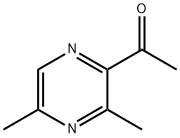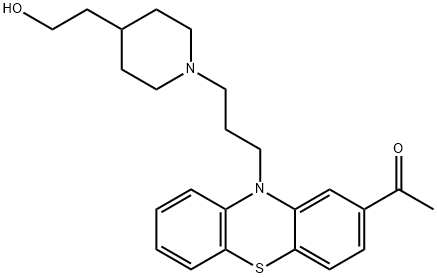2-Acetyl-3,5-dimethylpyrazine
- CAS NO.:54300-08-2
- Empirical Formula: C8H10N2O
- Molecular Weight: 150.18
- MDL number: MFCD00055023
- EINECS: 259-076-0
- SAFETY DATA SHEET (SDS)
- Update Date: 2024-12-18 14:08:52

What is 2-Acetyl-3,5-dimethylpyrazine?
Chemical properties
It has an odor of roasted hazelnut with caramel popcorn nuances.
Occurrence
Reported found in coffee
Preparation
From the corresponding dimethyl-ethylpyrazine by bromination, followed by oxidation to the ketone
Definition
ChEBI: 2-Acetyl-3,5-dimethylpyrazine is an aromatic ketone.
Aroma threshold values
Detection at 1%: musty roasted cocoa, nutty peanut with caramel-like nuance.
Taste threshold values
Taste characteristics at 5 ppm: almond, caramel, cocoa, hazelnut, peanut, pistachio, toffee and coffeelike.
Properties of 2-Acetyl-3,5-dimethylpyrazine
| Boiling point: | 70 °C7 mm Hg(lit.) |
| Density | 1.073 g/mL at 25 °C(lit.) |
| vapor pressure | 3 mm Hg ( 20 °C) |
| refractive index | n |
| FEMA | 3327 | 2-ACETYL-3,5(AND 6)-DIMETHYLPYRAZINE |
| Flash point: | 195 °F |
| storage temp. | Sealed in dry,Room Temperature |
| form | clear liquid |
| pka | 1.25±0.10(Predicted) |
| color | Colorless to Light orange to Yellow |
| Odor | at 0.10 % in propylene glycol. nutty roasted hazelnut |
| JECFA Number | 786 |
| CAS DataBase Reference | 54300-08-2(CAS DataBase Reference) |
| NIST Chemistry Reference | Ethanone, 1-(3,5-dimethylpyrazinyl)-(54300-08-2) |
| EPA Substance Registry System | Ethanone, 1-(3,5-dimethylpyrazinyl)- (54300-08-2) |
Safety information for 2-Acetyl-3,5-dimethylpyrazine
| Signal word | Warning |
| Pictogram(s) |
 Exclamation Mark Irritant GHS07 |
| GHS Hazard Statements |
H315:Skin corrosion/irritation H319:Serious eye damage/eye irritation H335:Specific target organ toxicity, single exposure;Respiratory tract irritation |
| Precautionary Statement Codes |
P261:Avoid breathing dust/fume/gas/mist/vapours/spray. P264:Wash hands thoroughly after handling. P264:Wash skin thouroughly after handling. P271:Use only outdoors or in a well-ventilated area. P280:Wear protective gloves/protective clothing/eye protection/face protection. P302+P352:IF ON SKIN: wash with plenty of soap and water. P305+P351+P338:IF IN EYES: Rinse cautiously with water for several minutes. Remove contact lenses, if present and easy to do. Continuerinsing. |
Computed Descriptors for 2-Acetyl-3,5-dimethylpyrazine
New Products
Tert-butyl bis(2-chloroethyl)carbamate (S)-3-Aminobutanenitrile hydrochloride N-Boc-D-alaninol N-BOC-D/L-ALANINOL N-octanoyl benzotriazole 3-Morpholino-1-(4-nitrophenyl)-5,6-dihydropyridin- 2(1H)-one Furan-2,5-Dicarboxylic Acid Tropic acid Fmoc-Val-Cit-PAB DIETHYL AMINOMALONATE HYDROCHLORIDE 1,1’-CARBONYLDIIMIDAZOLE R-2-BENZYLOXY PROPIONIC ACID 1,1’-CARBONYLDI (1,2-4 TRIAZOLE) N-METHYL INDAZOLE-3-CARBOXYLIC ACID (2-Hydroxyphenyl)acetonitrile 4-Bromopyrazole 5-BROMO-2CYANO PYRIDINE 5-broMo-2-chloro-N-cyclopentylpyriMidin-4-aMine 2-(Cyanocyclohexyl)acetic acid 4-methoxy-3,5-dinitropyridine 2-aminopropyl benzoate hydrochloride 1-(4-(aminomethyl)benzyl)urea hydrochloride tert-butyl 4- (ureidomethyl)benzylcarbamate diethyl 2-(2-((tertbutoxycarbonyl)amino) ethyl)malonateRelated products of tetrahydrofuran








You may like
-
 2-Acetyl-3,5-dimethylpyrazine (contains 2-Acetyl-3,6-dimethylpyrazine) CAS 54300-08-2View Details
2-Acetyl-3,5-dimethylpyrazine (contains 2-Acetyl-3,6-dimethylpyrazine) CAS 54300-08-2View Details
54300-08-2 -
 1975-50-4 98%View Details
1975-50-4 98%View Details
1975-50-4 -
 2-HYDROXY BENZYL ALCOHOL 98%View Details
2-HYDROXY BENZYL ALCOHOL 98%View Details
90-01-7 -
 2-Chloro-1,3-Bis(Dimethylamino)Trimethinium Hexafluorophosphate 221615-75-4 98%View Details
2-Chloro-1,3-Bis(Dimethylamino)Trimethinium Hexafluorophosphate 221615-75-4 98%View Details
221615-75-4 -
 61397-56-6 CIS BROMO BENZOATE 98%View Details
61397-56-6 CIS BROMO BENZOATE 98%View Details
61397-56-6 -
 14714-50-2 (2-Hydroxyphenyl)acetonitrile 98+View Details
14714-50-2 (2-Hydroxyphenyl)acetonitrile 98+View Details
14714-50-2 -
 118753-70-1 98+View Details
118753-70-1 98+View Details
118753-70-1 -
 733039-20-8 5-broMo-2-chloro-N-cyclopentylpyriMidin-4-aMine 98+View Details
733039-20-8 5-broMo-2-chloro-N-cyclopentylpyriMidin-4-aMine 98+View Details
733039-20-8
Statement: All products displayed on this website are only used for non medical purposes such as industrial applications or scientific research, and cannot be used for clinical diagnosis or treatment of humans or animals. They are not medicinal or edible.